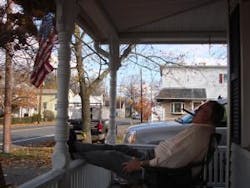In any given period of time, the incident you will see at least as often as any other involves a fire in a motor vehicle. Generally these will be classed as car fires, but we have seen out share of box van, and tractor-trailer scenarios.
The average car fire is not a real challenge, but it this very fact of life that makes working with them such a problem. All of us are subject to becoming complacent when it comes to fighting a car fire. We have seen people who skip the self-contained breathing apparatus.
There are those who turnout without their turnout gear. And who can forget the booster line buddies who go after a blazing car with the red line. Any one of a series of very common errors can very quickly come back to haunt you.
How should you approach a car fire? Carefully, from an upgrade position, preferably up wind. In case there is a release of flaming product, you want to watch it run away from you, rather than towards you. It has been our practice to attack vehicle fires with a minimum of two 1-3/4" hand lines. One line serves as the primary attack line, which the other is a back up; just in case something goes wrong.
Let us take a look at our sizeup procedure. Base your reading on the picture above.
- What have I got? You have a fire in the trailer section of a tractor-trailer unit. But what have you really got? Until you can review the shipping papers, you just will not know.
- Where is it? Somewhere in the midst of a jumble of cargo in the center area a commercial trailer unit. Perhaps the driver can assist you, by telling you which part of the load contains what materials; if they know. Many times the driver is not there when the cargo is being placed on board. However, it is better to talk to the driver than not.
- Where is it going? In the absence of an exposure problem, you might not have anything more than a mobile room and contents fire. But you must be able to identify the contents of the room, if you are to avoid blowing yourself to Kingdom come.
- What forces are available to combat this threat? Whatever your standard response is to a vehicle fire. In some fire departments, a vehicle fire receives a single engine company response. We have found this to be inadequate. We would suggest that as a minimum, your response should be an engine company, a truck or service company, and a chief officer. In areas where there is a water supply problem, a second pumper or a tanker pumper should be added to the response.
- What can I do? Deploy your forces to best advantage. Place your units upwind and upgrade. Stretch two hand lines of a minimum 1 3/4-inch size. Insure that all personnel are wearing full personal protective equipment, and are equipped with SCBA. Remember, that if you think you need help, call it. Do not attempt to be a hero with other people's lives.
In those cases, where you find that the reported vehicle fire is in a structure, call for a full structural response. We have encountered this a number of times during our career. It is a real surprise; but a calm reaction from you can keep things from turning into a disaster.
There was an incident in New Jersey recently where an explosion in the trailer body of a tractor-trailer vehicle injured seven firefighters, one of them critically. They were attacking the fire through the rear door. At some point as they attempting to open a side door in the trailer, an explosion blew out the door, striking one of the members and critically injuring him.
At first glance, you might ask what was in the cargo load. Was it pain, or explosives, or something flammable or ignitable. My friends, this was a truck load of tangerines. A fire in a load of citrus products produced an explosion serious enough to injure seven people and spew the contents of the trailer for several hundred yards in every direction. You must approach every vehicle fire with the greatest amount of caution. You just never know.
It is important to train your people in the latest technical and safety improvements. Air bags, hydraulic bumpers and power equipment present challenges that we of an earlier generation did not face. It is not our purpose here to teach you how to use each, but rather to call your attention to the fact that there are many points to ponder. You can find out a great deal by talking to an auto repairperson, an auto body repair specialist; or a technical rescue technician.
This is a case where a few moments spent in learning can prevent a lot of time recovering in a hospital. The simple act of wearing a SCBA may well prevent a great deal of future suffering.
Vehicle fires are common. We just ask that you not become complacent. Drills spent learning to control these types of incidents can pay dividends.
About the Author

Dr. Harry Carter
HARRY R. CARTER, Ph.D., who is a Firehouse contributing editor, is a fire protection consultant based in Adelphia, NJ. He is chairman of the Board of Commissioners in Howell Township Fire District 2 and retired from the Newark, NJ, Fire Department as a battalion commander. Carter has been a member of the Adelphia Fire Company since 1971, serving as chief in 1991. He is a life member and past president of the International Society of Fire Service Instructors and life member of the NFPA. He is the immediate past president of the U.S. branch of the Institution of Fire Engineers (IFE) of Great Britain. Carter holds a Ph.D. in organization and management from Capella University in Minneapolis, MN.
Connect with Harry:
Email: [email protected]
